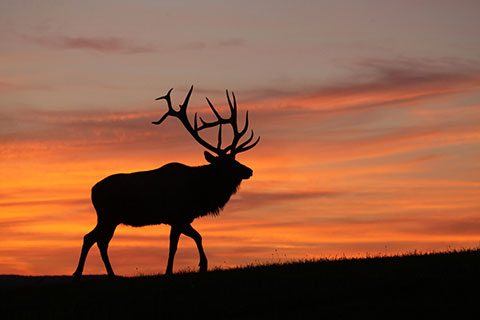PENDLETON, Ore. — Verlyn Savage may speak elk, but there’s more than one language.
At the Pendleton Convention Center, Savage stood in front of a crowd of hundreds, lifted a bugle to his mouth, and blew a series of short, high-pitched sounds that faded into a rasp.
“Notice any difference?” he asked the crowd of mostly children.
“Yes,” some yelled back, already picking up the skill after their first elk bugling lesson.
“When a bull starts bugling, try to match its intensity,” he said.
“When they’re talking certain languages you have to know what they’re talking, because sometimes they’ll let out a bugle that’s different than what they’ve been bugling, that means he’s grabbing his cows and leaving,” he told the audience. “You’ve got to start distinguishing how this bull reacts to your bugle.”
Savage was one of the speakers at the Rocky Mountain Elk Foundation’s first youth outdoor skills day. More than a thousand people showed up for the event, which aimed to teach kids about how hunting and outdoor recreation relate to conservation.
“You see a lot of people who don’t really understand what (it) is,” said event organizer Korie Campbell. “The future of conservation depends on the next generation. The goal is to get these kids exposed.”
Campbell, a Pendleton native, is currently attending college in Missoula, Montana, where she studies wildlife biology. She works for the Rocky Mountain Elk Foundation headquarters, where she plans educational events. In August she called her father, Tim Campbell, who is in the local RMEF chapter, about hosting an event specifically aimed at teaching youth.
“Our chapter had wanted to do a youth event,” he said. “This is Korie’s passion.”
Though he runs a drywall company by day, Savage is a longtime hunter, and gives several presentations a year on elk calling.
Though much of his skill at elk-bugling is self-taught, Savage said each year, he has to do some revision.
“Some techniques, you really just have to be out in the woods and find out how animals react,” he said.
And, he said, the quality of the call doesn’t guarantee you’ll be attracting an elk.
“People are getting so good at these, it’s really hard to tell,” he said. But, he said, being a good bugler doesn’t necessarily mean you can fool an elk.
“Some of the worst calls I’ve heard have been from elk,” he told the crowd.
Representatives of several groups, including the U.S. Forest Service, Oregon Back Country Hunters and Anglers and Umatilla County Search and Rescue, were at the event, talking to kids about conservation and safety.
There were also several activities, such as skull and track identification, a BB gun shoot, an archery range, and presentations for how to use trail cameras and film hunting trips.
“My favorite part of today is going to be archery,” said James Montee, 12, as he and his friends waited in a long line to go to the archery range.
Montee and his friends, Elijah McLaughlin and Jesse Acosta, are in the process of taking hunting safety classes now. Some of the organizations tried to help children understand some of the broader concepts of outdoor recreation.
“The places where we go hiking, camping, fishing – do you guys do any of that stuff?” Jesse Salsberry of Back Country Hunters and Anglers asked a pair of three-year-olds, who nodded.
“A lot of time when you do that, that’s on public land,” he said. “That means everyone in the U.S. shares that land, from people in New York to right here in Pendleton.”
Bill Welch, also of Back Country Hunters, said it can be challenging to get kids to understand the concept of public land.
“We try to tie it in to what kids like to do,” he said.


